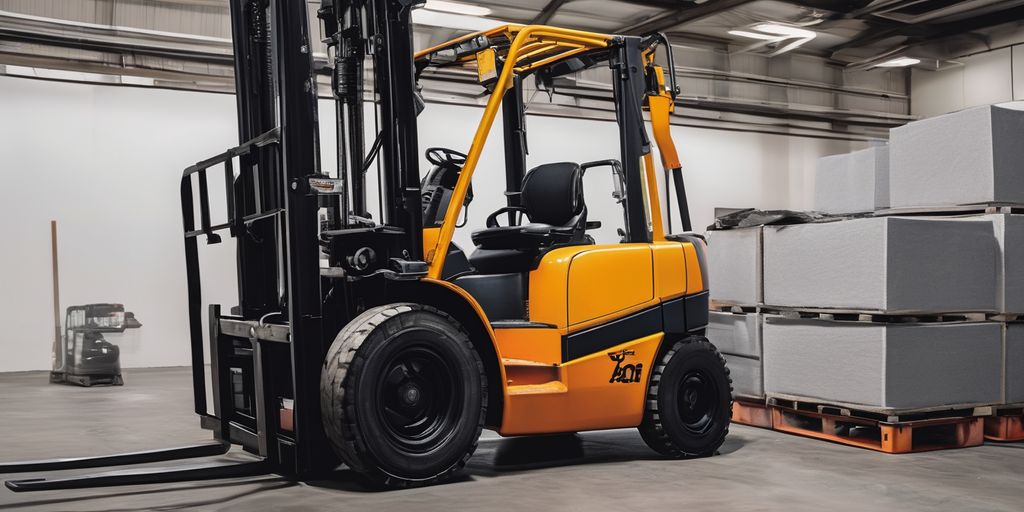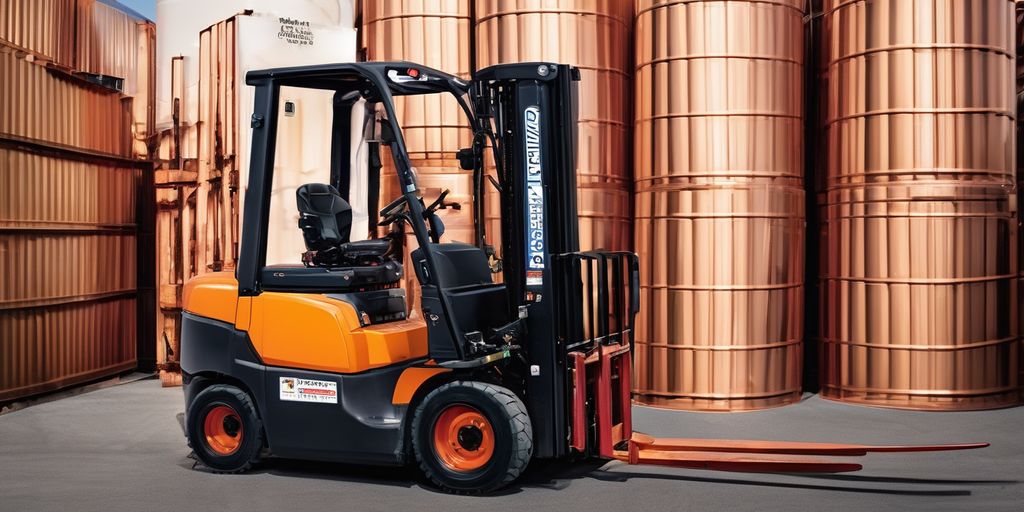Choosing the right tires for your forklift is essential for getting the best performance, safety, and efficiency. The type of tires you need depends on where you use the forklift, how much weight it carries, and the kind of surface it drives on. In this guide, we will talk about the different types of forklift tires, what to consider when choosing them, and how to take care of them. We will also give tips on avoiding common mistakes and offer expert advice for different work environments.
Key Takeaways
- Selecting the right forklift tires improves safety and performance.
- Different types of tires are suited for different terrains and uses.
- Consider the operating environment, load capacity, and surface conditions when choosing tires.
- Proper tire maintenance extends the life of your forklift tires.
- Avoid common mistakes like ignoring manufacturer recommendations and focusing only on price.
Understanding Different Forklift Tire Types

Choosing the right forklift tires is crucial for efficiency, safety, and informed decision-making. This informative article on choosing the right forklift for specific needs covers types, considerations, and safety tips. Let's dive into the different types of forklift tires and their unique benefits.
Cushion Tires
Cushion tires are made of solid rubber and are best suited for indoor use on smooth surfaces. They offer a smaller turning radius, making them ideal for tight spaces like warehouses. However, they are not suitable for rough or uneven terrains.
Pneumatic Tires
Pneumatic tires are filled with air and resemble car tires. They are designed for outdoor use and can handle rough and uneven surfaces. These tires provide better traction and a smoother ride, but they require regular maintenance to avoid punctures.
Solid Pneumatic Tires
Solid pneumatic tires are similar to pneumatic tires but are made of solid rubber. They are puncture-proof and require less maintenance, making them ideal for harsh outdoor environments. They offer the durability of cushion tires with the outdoor capabilities of pneumatic tires.
Understanding the essential parts of a fork truck, including tires, is key to maximizing performance and safety.
By knowing the different types of forklift tires, you can make an informed decision that enhances your forklift's performance and safety.
Factors to Consider When Choosing Forklift Tires
Selecting the right tires for your forklift is essential for optimal performance and safety. Here are the key factors to consider:
Operating Environment
The environment where the forklift operates plays a significant role in tire selection. For instance, indoor warehouses typically require different tires than outdoor construction sites. Consider whether the terrain is smooth or rugged, and if the area is prone to debris or chemicals.
Load Capacity
The weight your forklift will carry is crucial. Tires must support the maximum load without compromising stability. Overloading can lead to tire damage and unsafe conditions.
Surface Conditions
Evaluate the surfaces your forklift will traverse. Smooth concrete floors, gravel paths, and uneven terrains each demand specific tire types. Proper tire selection ensures better traction and reduces wear and tear.
Remember, choosing the right tires for your forklift depends on many factors, like the type of tires and typical usage. Use this guide to make the best choice.
Benefits of Proper Forklift Tire Selection
Choosing the right tires for your forklift is essential for achieving the best performance, safety, and efficiency. Properly selected tires contribute to the forklift's stability, preventing tipping or sliding, which is crucial for the safety of operators and nearby personnel.
Tire Tread Patterns and Their Applications
All-Purpose Treads
All-purpose treads are versatile and can be used in various environments. They are suitable for both indoor and outdoor use, providing a balance between traction and durability. These treads are ideal for general-purpose applications where the terrain is not too extreme.
Traction Treads
Traction treads feature lug patterns that are offset on the tire’s surface. This design enhances grip, making them perfect for outdoor or uneven surface applications. They are especially useful in environments where maintaining traction is crucial, such as construction sites or rough terrains.
Heat Dissipation Treads
Heat dissipation treads are designed to manage the heat generated during forklift operations. These treads help in preventing overheating, which can lead to tire damage. They are particularly beneficial in high-intensity applications where forklifts are used continuously for long periods.
Regularly checking your forklift tires for any visible cracks, cuts, or bulges on the tire sidewalls can help in maintaining their performance and longevity.
Maintenance Tips for Forklift Tires
Regular Inspections
You should make regular inspections of your tires as part of your maintenance and safety check procedures. You want to make sure they are in good condition and wearing evenly. If you see any warning signs of tire fatigue, it may be time to replace your forklift tires.
Proper Inflation
Ensure your tires are inflated to the proper air pressure to maximize performance and minimize wear. Proper inflation helps in maintaining the longevity and efficiency of your forklift.
Timely Replacements
A tire in good condition will increase your forklift’s efficiency, improve productivity, and reduce operator fatigue. Timely replacements are crucial to avoid unexpected downtimes and safety risks.
Master tire maintenance with the Elevex guide to ensure the longevity and performance of your forklift. Follow our expert tips for thorough inspection and maintenance.
- Regular inspections
- Proper inflation
- Timely replacements
Common Mistakes to Avoid When Selecting Forklift Tires
Ignoring Manufacturer Recommendations
One of the most common mistakes is ignoring the manufacturer's recommendations. These guidelines are there for a reason and help ensure that your forklift operates safely and efficiently. Not following these recommendations can lead to serious accidents, increased repair costs, and decreased forklift performance.
Overlooking Environmental Factors
Another frequent error is overlooking the environmental factors where the forklift will be used. Different terrains require different types of tires. For example, using indoor tires on rough outdoor surfaces can cause rapid wear and tear, reducing the lifespan of the tires and compromising safety.
Choosing Based on Price Alone
While it might be tempting to choose the cheapest option, this can be a costly mistake in the long run. Cheaper tires often wear out faster and may not provide the necessary support for your specific needs. Investing in quality tires can save you money on maintenance and replacements over time.
Proper tire selection is crucial for maintaining workplace safety and productivity. Always consider the operating environment, load capacity, and surface conditions when choosing forklift tires.
Expert Recommendations for Specific Applications
Indoor Warehousing
For indoor warehousing, cushion tires are the go-to choice. They offer excellent stability and maneuverability on smooth surfaces. These tires also reduce vibration, which can enhance productivity in a warehouse setting.
Outdoor Construction
When it comes to outdoor construction, pneumatic tires are highly recommended. They provide the necessary traction and shock absorption for rough or uneven terrain. If you need extra puncture resistance, opt for solid pneumatic tires.
Cold Storage
In cold storage environments, it's crucial to select tires that can withstand low temperatures. Solid pneumatic tires are often preferred for their durability and ability to maintain performance in freezing conditions.
When selecting forklift tires, it's crucial to consider your application, forklift model, and work environment. Various applications call for different tire types to ensure optimal performance and safety.
Conclusion
Choosing the right forklift tires is essential for ensuring safety, efficiency, and performance in various work environments. By understanding the different types of tires and their specific uses, you can make an informed decision that best suits your needs. Always consider the type of forklift, the nature of the terrain, and the specific tasks at hand. If you're ever unsure, don't hesitate to seek advice from experts. The right tires can make a significant difference in your forklift's operation, so take the time to choose wisely.
Frequently Asked Questions
How do I choose the right forklift tires?
Choosing the right forklift tires depends on your specific needs and application. Consider factors like the type of forklift, the environment it will operate in, the load it will carry, and the surface conditions. If you're unsure, consult with experts to find the best solution.
What are the different types of forklift tires?
There are several types of forklift tires, including cushion tires, pneumatic tires, and solid pneumatic tires. Each type is designed for different environments and applications.
Why is it important to choose the right forklift tire tread?
The right tire tread can significantly impact performance. All-purpose treads offer solid overall performance, while specific treads can provide better traction on wet or uneven surfaces, or help with heat dissipation.
How often should I inspect my forklift tires?
Regular inspections are crucial for maintaining forklift safety and performance. Check your tires frequently for signs of wear and tear, proper inflation, and any damage that might require immediate attention.
What are common mistakes to avoid when selecting forklift tires?
Common mistakes include ignoring manufacturer recommendations, overlooking environmental factors, and choosing tires based solely on price. These mistakes can lead to poor performance and safety issues.
Can I use the same forklift tires for indoor and outdoor applications?
It's not recommended to use the same tires for both indoor and outdoor applications. Different environments require different tire types to ensure safety, performance, and efficiency.




Leave a comment
This site is protected by hCaptcha and the hCaptcha Privacy Policy and Terms of Service apply.